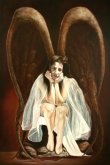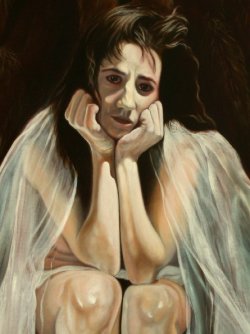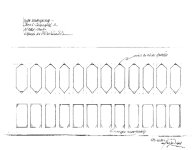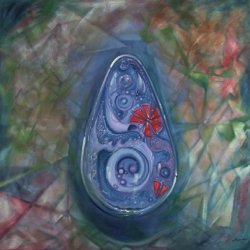 Guy
Benson was born in Point St-Charles, Quebec. He has studied art
binding, graphic art, drawing and illustration. In 1972, he began
working as an artist in what he calls a "logical succession
of studies and technical findings." He has exhibited in both
Canada and the United States at: Intercités, Repentigny,
Quebec, Galerie Gora, Montreal, Main Street Gallery, Maine, USA,
to mention a few; and won the 2nd Prize "Public's Choice"
in Montreal (1988). He makes his home and pursues his artistic
career in Repentigny, Quebec.
Guy
Benson was born in Point St-Charles, Quebec. He has studied art
binding, graphic art, drawing and illustration. In 1972, he began
working as an artist in what he calls a "logical succession
of studies and technical findings." He has exhibited in both
Canada and the United States at: Intercités, Repentigny,
Quebec, Galerie Gora, Montreal, Main Street Gallery, Maine, USA,
to mention a few; and won the 2nd Prize "Public's Choice"
in Montreal (1988). He makes his home and pursues his artistic
career in Repentigny, Quebec.
*
* * * * * * * * * *
Motivation: the
exploration of the components of the painted matter
for what it offers the artist and for what it permits the artist
to reveal.
Guy Benson

I met Guy Benson by chance one
afternoon and he showed me the images of his Archangels' Series.
They left quite an impression on me and gave me the desire to
see them first hand. I went to meet Benson in his studio one afternoon
with the idea that seeing him in his working surroundings would
give me a better understanding of the artist and his work. After
two or three hours of lively conversation, I realized I was speaking
with a man who is not only a good artist but who is also highly
cultured and a philosopher.
Benson is an honest painter who
believes in making a valuable contribution to society as an artist.
He believes that, fundamentally, creative people cannot escape
what they are. According to him, artists are individuals endowed
with intelligence, conscience and spirituality. These dimensions
of their personality inevitably manifest themselves in the artists'
creations. Benson acknowledges that education, environment, knowledge
and the times we live in play a part in conditioning artists.
Nevertheless, he states, the artist creates freely and authenticity
is a matter of conscience. He goes on to say, conscience is the
guarantor of integrity in the same way assiduity and perseverance
are guarantors of skill. At the same time, he admits that we live
in a society in which integrity and authenticity in art are often
ridiculed or manipulated solely for commercial reasons. "The
responsibility of preserving them (integrity and authenticity)
rests upon us, artists."
Despite the fact that Guy Benson
has studied graphic design, publicity drawing and illustration,
he describes himself as self-taught. And although at the beginning
I had certain doubts about accepting this assertion, I now understand
and accept it.
Benson declares that his inspiration
has its sources in the scientific and artistic heritage bequeathed
by the creators of past centuries. And he adds, "Mystified
by the ancient artists who practiced drawing and painting, I have
tried to capture the enigma." Thus, Benson takes on a movement
and/or an artist as a project and begins his in-depth study.
The Archangels' Series,
1990-1998 - named in the original French Études Archangéliques,
is an outstanding example of the aforementioned process. In this
series, Guy Benson takes the Baroque style and more precisely
the traits of Michelangelo Merisi, called il Caravaggio,
to create a series of five works depicting archangels to whom
the artist gives the names of five human qualities and emotional
states: Sérénité (Serenity), Compassion
(Compassion), Abandon (Abandonment), Volonté (Will), Douleur
(Pain).





The painter skilfully executes
the chiaroscuro in order to emphasize the intensity of the figures
depicted in these works; his ability to master Baroque technique
is evident.

Furthermore, Benson takes his
exercise into a deeper area, thus capturing the characteristics
which set the unruly Caravaggio apart from all other masters of
the Baroque period: first, the psychological realism imprinted
in his images and second, the portrayal of religious subject matter
and personae as every day life events and characters. Although
Benson's archangels are devoid of any religious content, we must
recognize the significance of the artist's selected presentation
of the figures as angels and down to earth humans. Benson's high-ranking
angels are bestowed with wings and, hence, they have a celestial
nature; however, the wings are so cumbersome their intrinsic celestial
attributes are a burden rather than aerie appendages that move
easily. The psychological state of the figures is emphasized by
their pose and facial expression. Case in point, it is hard to
stand before Douleur in all its imposing size without being
deeply touched by the almost tangible sadness reflected in the
eyes of this angel.
This sadness is revealed in the
pose of the angel and subtly emphasized by the actual modelling
of the figure. This is visible in the angular shapes of the body
and the colouring of the skin. In contrast with the darker shadowy
parts, pale tones show through the blue/grey veins of the legs.
The pallid color of the skin is accentuated by highlights which
contribute to its fragile transparency. The same blue/grey color
of the veins is used to create the shadows in the veil; thus,
the artist unifies figure and drapery. Undoubtedly, this painting,
which by the artist's own admission may very well be a self-portrait,
expresses a deep sense of isolation and longing for human contact
and warmth.

Today Guy Benson is working on
another series, the Ab Ovo, which is a literary term describing
the practice of beginning a narrative at the earliest possible
chronological point.



Ab Ovo is an ambitious
project of 24 paintings depicting the basic ovoid shape. As seen
in one of the sketches, twelve of these paintings will be created
in a rectangular shaped canvas, the other twelve in a hexagonal
one. The medium is oil. The corners of each work will feature
an ornament of embossed copper as shown in another sketch. The
egg in the centre of the composition is created in contrast to
the freer and more diffused forms in the background. Inside it,
double helix forms, different cellular forms and other basic shapes
are used to create different motifs. This is an approach utilizing
forms related to the simplest and most elemental organic shapes.
Although I do not believe the


artist is trying to create the
pictorial equivalent to a narrative at the earliest possible
chronological point, I find his choice of subject and the
title of the series quite telling. The final product will be a
set of purely decorative objects but the selection of their pure
essential forms demonstrates an internal search, the search for
Guy Benson.
Benson sees this adventure as
a vehicle to continue his research of the art of painting. I see
it as a creative research through elemental shapes guided by the
clarity and logic in their relationships. But, more importantly
and without taking away any of the creative and artistic value
from the Ab Ovo series, I see it as a sort of pause, a
very valid dilettante's exercise, a very personal and instinctive
exploration of the artist's own identity.
In a way, Guy Benson has already
given an indication of this identity in his work Douleur d'aimer
- géopolitique of 1992; a transitional painting executed
after the conception of the Archangels' Series and before
the Ab Ovo series.

In this painting Benson communicates
his essence as painter/creator. He declares that humanism is not
out of fashion. He embraces the challenge of producing works of
art which are cultural manifestations and products of an environment
in which history, philosophy, literature, science, political circumstances,
social reality and geographic location all play a role.
In the Ab Ovo series, as
in the Archangels' Series, Guy Benson's great ability as
draftsman, colorist and master of all the nuances of painting
is evident. The Ab Ovo could mark a starting point and I am looking
forward to seeing its completion. Partly because I would like
to see the final result of this interesting project and I am anxious
to see its impact on the painter’s aesthetic vocabulary.
Mainly, because I hope that, after Av Ovo, Guy Benson will put
aside his research work and will apply all his creative ability
to the development and fulfillment of his unique artistic identity.
Editor's
note: To find more about the artist or to get in touch with him,
please write to contact@artsandopinion.com,
to the attention of Marissa Consiglieri de Chackal - Arts Editor.